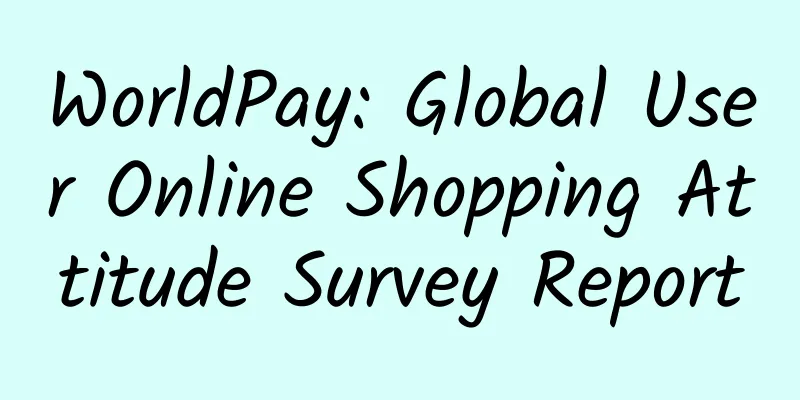WorldPay: Global User Online Shopping Attitude Survey Report

|
On May 2, 2012, WorldPay, a corporate payment service provider, recently released a global survey report on users' attitudes towards online shopping. Using the e-commerce markets of 15 representative countries around the world as samples, the report analyzed how consumers shop online, their online spending, mobile shopping, and their attitudes towards online shopping. The report shows that, on average, global online shoppers spend 22% of their disposable income on online shopping, while the proportion for Chinese users is 31%; only 9% of Chinese users said they would never spend more than 50% of their disposable income on online shopping, while the world average is 36%. The following are the main contents of WorldPay's global online shopping report: The development path of online shopping from reform to evolution When e-commerce emerged in the mid-1990s, it changed everything. Business models established at the turn of the 20th century quickly became obsolete, and retailers around the world soon found themselves adapting to a world where customers were coming from all over the world and shopping at all times of the day and night. After 17 years of rapid development, e-commerce is still in a state of constant instability. If technology was the catalyst behind the initial online shopping revolution, today we see that any factor can drive e-commerce to the next stage of evolution. In the context of the global economy, the rapid development of the BRICS countries has created a new generation of enthusiastic and innovative shoppers. The rapid development of mobile technology has created an "always online" shopping generation. Faster and more popular Internet has expanded the customer base of retailers. Social media has made it easier for us to share and rate the products we buy and shopping experiences. E-commerce and the “channels” through which we shop may continue to change, but one thing that will remain constant is the importance of the payment experience. As the end point of the consumer shopping experience, a poor payment process can be a huge obstacle. The product may be great and the price may be perfect, but if the transaction cannot be completed simply and quickly, the overall shopping experience will quickly deteriorate. For e-commerce retailers, this has never been more important. Technology has made their business accessible to more customers than ever before, but it has also created fierce competition. Another online store is just a click away, and shopper loyalty means more than just giving them a top-notch online store or an unbeatable price. It also means making payment as easy as possible, anytime, any way. In this report, we surveyed more than 19,000 online shoppers from around the world and collated insights from more than 150 major online retailers. What we found is that many retailers are failing to think about what consumers are thinking about. How the World Shops Online To determine whether online retailers are meeting consumer needs and where they are falling short, we first need to look at consumer behavior outside of retailers’ direct sphere of influence. Understanding when, where and how consumers shop helps online retailers better understand their customers, opening windows for greater opportunities to engage with and sell to them. We'll look at global trends in online shopping behavior and key regional differences. 1. Which countries spend the most on online shopping? We asked respondents what percentage of their disposable income they spend online, and globally, 22% of consumers’ disposable income is spent online. This number is growing rapidly in India, Brazil, and China, where shoppers spend nearly a third of their annual income online. Chinese and Indian consumers spend more of their disposable income online Shoppers in many countries consume and spend in concentrated periods of time. On average, respondents spend five hours per month shopping online, which includes the entire “shopping journey” from browsing, to researching products, to purchasing. Regional differences are worth noting. Chinese and Indian users spend the most time on online shopping, up to 8 hours per month. However, users in Finland, Japan, Spain and France spend less than 4 hours per month on online shopping. The huge differences in mobile device ownership and use have an important impact on online shopping behavior. The high penetration rate of smartphones in the Asia-Pacific region provides greater opportunities for online shopping for users in the region. If we ignore regional differences, it is clear that online retailers have limited opportunities to attract users. Even heavy online shoppers only spend a few hours a week online, so it is important to accurately target, attract and satisfy customers. 2. When, where and how to shop online? Globally, consumers spend more in the second half of the day, with 74% of global online shopping transactions occurring between noon and midnight, with the majority (44%) occurring in the evening. Therefore, the "golden time" for global online shopping is 20:40, so online retailers can launch promotional activities during this time, such as discount sales, special sales, or exclusive sales. The best time for online shopping worldwide is 20:40 p.m. Location is another important factor in online shopping. The popularity of mobile devices has had a significant impact on shopping habits, but it is worth noting that 95% of online shopping transactions worldwide are still completed at home, and 64% of consumers still use their home computers to shop online. 54% of consumers say they shop online from their living room At the same time, the convenience of mobile shopping has had an impact on the shopping habits of global consumers. 29% of global shoppers shop online at work, 6% shop online on college campuses, in cars or in physical retail stores, 7% shop online in cafes, bars and restaurants, and 8% shop online during holidays. For retailers, multi-channel promotions are becoming increasingly important. Many online shoppers do other things while shopping. 46% of respondents said they shop online while watching TV, 42% while listening to music, 21% while listening to the radio, 29% while chatting with family or friends, and 31% while using social networks. It can be seen that retailers need to work hard to attract consumers' attention. Heavy shoppers are more likely to use multiple devices, with 36% of heavy shoppers using smartphones, compared to 17% of moderate and 7% of light shoppers. Similarly, 23% of heavy shoppers use tablets, compared to 9% of moderate and 3% of light shoppers. Internet-enabled TVs, or “smart TVs,” are still new, but they are already having an impact on online shoppers. Overall, 5% of global online shoppers have made purchases through the new generation of TVs, which could be the next generation of opportunity for online retailers. 3. Payment Methods Regarding the payment methods of global online shoppers, many well-known service providers are on the list. In the past six months, 69% of respondents said they used credit cards for online shopping, 40% used PayPal, 37% used debit cards, and about 19% used bank transfers. There are also many potential payment options. For example, in the past six months, many online shoppers have also used other payment tools, including gift vouchers (14%), Alipay (8%), mobile payments (7%), and cash vouchers (5%). Adapting to the diversity of payment options is important, as 61% of respondents said they trust websites that offer multiple payment options more. In addition, payment methods are even more important in attracting heavy online shoppers, more than 30% of whom have used local payment, stored-value cards, cash vouchers, mobile payments or debit cards to make purchases in the past six months. Global Overview Online retailers want customers to come back for more, so they spare no effort to attract them through advertising, social media, public relations, etc. The survey shows that the cheapest price (51%) and the retailer's brand (39%) are important, but they are not the most important factors for attracting consumers to come back. The most important factors listed by consumers are: - Security of personal and financial information, 75%; Payment security, 66% - After-sales guarantee of goods or services, 57%. From the perspective of merchants, they believe that the three factors that most attract consumers to come back are completely different: - Website design and layout, 67%; - Website navigation quality, 62%; - Overall speed of the shopping experience, 62%. In terms of how to attract consumers to increase spending, consumers and merchants have relatively consistent views, and both sides believe that more payment options and customized special services are important factors. However, there are also some important differences. For example, more than half of consumers believe that payment security and personal information protection are the most important factors for increasing spending, while merchants believe that faster payment processes are the most important factors. Consumers and businesses also disagree on how to attract consumers to increase spending Unexpected costs put online shoppers off the market Abandoning online shopping at the shopping cart stage is a serious problem faced by online retailers. Industry data shows that the current "shopping cart abandonment" rate is as high as 75%, which causes online retailers to lose $18 billion each year. In this survey, more than half of consumers admitted that they often abandon shopping at the checkout stage. Obviously, reducing shopping abandonment behavior can help retailers improve performance, but first of all, we must know why consumers abandon payment. Both consumers and merchants have given answers to this question. Nearly two-thirds (56%) of consumers abandon shopping because of unexpected fees, such as taxes and shipping costs, which will lead consumers to shop on competitors' websites. In the eyes of merchants, the main reason for consumers abandoning shopping is that they only browse and do not buy, which accounts for 45%. Interestingly, 36% of merchants believe that payment rejection is the main reason for abandoning shopping, while in the eyes of consumers, this reason only accounts for 11%. Consumers and merchants also disagree on the reasons for abandoning shopping Regarding how much of their disposable income was spent on online shopping in the past 12 months, heavy online shoppers spent 30% or more, moderate online shoppers spent 10% to 30%, and light online shoppers spent less than 10%. Although online shoppers of all levels are concerned about payment security and data protection, other factors vary. Light online shoppers pay more attention to simple factors such as delivery date and customization. Heavy online shoppers and some moderate online shoppers value value-added services such as cross-channel integration and online chat assistants. Although the specific situation in each country is different, global heavy online shoppers have higher expectations for online shopping experience. How much consumers spend on online shopping affects the reasons why they abandon their shopping. Unexpected expenses are a common factor that puts 62% of light online shoppers off, 57% of medium online shoppers, and 49% of heavy online shoppers off. However, the higher the online shopping spend, the more important it is to secure settlement, with this factor affecting heavy, medium, and light online shoppers at 23%, 17%, and 13%, respectively. Market maturity and emerging market opportunities By analyzing the spending in local markets, it can be seen that the proportion of heavy online shoppers is higher in emerging Internet markets. In mature Internet markets such as the United States and the United Kingdom, the distribution of heavy, medium and light online shoppers is relatively balanced, while in emerging markets such as China and India, the proportion of heavy online shoppers is higher, with 48% and 54% spending more than 30% of their disposable income on online shopping respectively. Only 18% of Chinese online shoppers and 16% of Indian online shoppers spend less than 10% of their disposable income on online shopping. In addition, in fast-growing economies such as China and India, not only is the proportion of heavy online shoppers higher, but the proportion of users who intend to spend more of their disposable income on online shopping is also higher. Only 9% of Chinese users said they would never spend more than 50% of their disposable income on online shopping, while 72% of Finnish users said they would never do so. Chinese and Indian consumers are more willing to spend more on online shopping Analyzing the e-commerce market in each country can provide a clearer understanding of their behaviors, factors that prevent and encourage their online shopping spending. In addition, there are many differences between different countries, from the willingness to shop on mobile to the attitude towards cross-channel shopping. China: China’s internet penetration rate of 38% may not be a staggering number, but considering that China has a population of 1.3 billion and is still growing rapidly, you know that this market has huge e-commerce potential. Add to that the fact that Chinese users have disposable income to spend online, and this golden opportunity is further amplified (in our survey, Chinese users showed some of the most relaxed spending habits, with respondents spending 31% of their disposable income on online shopping). The rate of fraud experience is also higher (19% vs. the global average of 14%). However, consumers are more concerned about online security (75%). Overview of the overall online shopping situation in China's e-commerce market Buying drivers and differences The driving force of e-commerce in China comes from a relatively wide range of people, but women in their 40s are the dominant force. People aged 26 to 32 also play an important role, representing the growing prosperity of economic development. Among them, clothes (40%) and food (39%) are the most popular online shopping products. These online shoppers are mainly concerned about the protection of their personal information, but many heavy online shoppers are always attracted to retailers that offer a variety of price options and spend more. Moderate online shoppers are attracted by accurate delivery dates and details, as are light online shoppers, who are also interested in customized products. Chinese online shoppers are less likely to abandon the checkout process due to unforeseen costs (33%, compared to a global average of 56%), but they are also more savvy, with 42% abandoning a purchase to find a better deal. Website navigation issues can cause retailers to lose nearly a third (38%) of potential customers. 42% of online shoppers abandon a purchase to find a cheaper price Mobile shopping interests The mobile opportunity among Chinese online shoppers is huge. Smartphone ownership is increasing (75%) and purchasing via these devices is popular (46%). More people are expected to shop via smartphone, with 48% of respondents expressing an interest in shopping via smartphone or tablet in the next year. This desire for mobile shopping explains why the average Chinese respondent owns 5.7 shopping apps. Mobile shopping has a bright future in China's e-commerce market Summarize China's e-commerce market is growing and will continue to grow as the electronic economy continues to develop rapidly. Mobile technology will play an important role and may help online retailers attract a large number of mobile device users to shop online. Key points for serving Chinese online shoppers: - Ensure the use of extremely popular Alipay and UnionPay as standard payment services; - Promote and provide security standards and data protection, use advanced risk management solutions, and educate customers about your security standards. Consider token practices and e-wallets to further reassure them; - Provide more personalized services to attract casual online shoppers; - In this land of huge mobile opportunities, make sure you are prepared: optimize your website, simplify mobile payment processing, and consider developing a dedicated app if feasible. USA The United States is a pioneer in online shopping. According to data released by Forrester, the growth rate of the US e-commerce market is expected to be close to 10% in the next three years, but the United States is still the world's largest online shopping market. In this mature market, the Internet penetration rate is 78%, and American users spend 23% of their disposable income on online shopping, which is comparable to the global level. As the world's largest market, the United States is particularly affected by online shopping fraud. 18% of users have experienced online shopping fraud, which is the highest proportion in the Americas and the global average is 14%. However, online shoppers are not overly concerned about security issues, with a proportion of 59%, which shows the maturity of the US e-commerce market and the stability of consumers. It is also worth noting that American users' interest in overseas shopping websites (22%) is only half of the global average (45%), and concerns about online shopping fraud are the biggest obstacle (60%). Buying drivers and differences As in other mature economies, heavy online shoppers in the US market are those under 25 years old. On average, heavy online shoppers believe that participation and entertainment experience are important reasons for increasing online shopping spending, medium online shoppers prefer customized transactions, and light online shoppers focus on actual logistics (accurate delivery date). This reflects the behavioral differences between different online shoppers around the world. Light online shoppers pay more attention to traditional offline shopping needs, while heavy online shoppers pay more attention to the quality of the online shopping experience itself. U.S. respondents cited unexpected costs (62%) and “just browsing” (47%) as the main reasons for abandoning an online purchase, which is much higher than the global average of 56% and 37%, respectively. 62% of American users would abandon online shopping due to unexpected costs Mobile shopping interests The level of mobile shopping in the United States is lower than the global average. The smartphone ownership rate is 41%, and the tablet ownership rate is 19%. The willingness to use smartphones or tablets for shopping in the next 12 months is 15% and 9% respectively, which is lower than the global average of 51% and 40%. American respondents believe that the lack of necessity and security concerns are the main reasons for not using smartphones for shopping, and viruses and spyware issues are also one of the reasons. However, the average level of shopping through smartphones in the United States is higher than the global average, with 3% of American users and 2.5% of the global level. Mobile shopping in the U.S. is lower than the world average Summarize The United States exhibits the characteristics of a healthy and mature online shopping market, namely generally conservative attitudes towards innovation (mobile), concerns about security issues, and high expectations for the online shopping experience itself. Key points for serving US online shoppers: - Experience quality helps drive online shoppers to increase spending; - Light and moderate online shoppers value customized services and logistics; - Security issues should be clearly communicated to this user group who are very familiar with the Internet; - Strengthen mobile optimization and expand its advantages to encourage users to shop on the go; - The more mature the market, the higher the price sensitivity and customer service requirements. India As a rapidly developing emerging economy, Indian users have shown great interest in online shopping. Although India's Internet penetration rate is only 10%, Indians spend one of the highest disposable income on online shopping (36%). In terms of security concerns and fraud experience, India is an extreme example, with 22% of online shoppers having experienced fraud, compared to the global average of 14%. However, their concerns about security are comparable to the global average of 63%. Indian users use mobile devices much higher than the global average. The smartphone ownership rate of Indian respondents is as high as 72%, and they also like to use smartphones for shopping. 40% of respondents said they use smartphones for shopping, while the global average is 19%. 54% of Indian respondents expressed their willingness to shop via smartphones in the next 12 months, and on average each respondent installed 5.5 shopping apps. Overall, the mobile opportunities in the Indian market will continue to grow rapidly from a high starting point. Brazil Brazil is the fastest growing country for online shopping outside of Asia, with a compound annual growth rate of 18% expected over the next three years, according to market research firm Forrester. Online shoppers spend 27% of their disposable income online, which is slightly higher than the global average of 23%, although Brazil's internet penetration rate is just over a third (37%). Compared with more mature markets, especially Europe, Brazilian online shoppers experience less fraud (11%) but are more concerned about security (67%). Website functionality plays an important role in Brazilian respondents’ attitudes toward mobile websites. Smartphone penetration in Brazil is as high as 50%, and the proportion of users who intend to use smartphones and tablets for online shopping is 46%, which is comparable to the global average. Whether the shopping website is optimized for mobile devices is one of the top three factors that influence whether Brazilian users will shop online via mobile devices. Argentina: Compared to other Latin American countries, Argentina has a high internet penetration rate. The proportion of people who shop online is as high as 66%, close to the level of Canada and the United States. As with more mature online shopping markets, Argentina's disposable income for online shopping (21%) is lower than the global average (23%). The proportion of Argentine users concerned about online shopping security is slightly higher than the average, at 66%, but the proportion of respondents who have experienced fraud is lower, at only 7%, compared to the global average of 14%. Argentina’s smartphone ownership rate (33%) is lower than other Latin American countries, which has an impact on mobile shopping, with only 8% of Argentine respondents shopping via smartphone. However, it is encouraging to note that 48% of online shoppers intend to use smartphones or tablets to shop in the next 12 months, compared to the global average of 40%. Canada Canada is a mature market in terms of internet usage and penetration, with an internet penetration rate of 79%. However, Canadian users spend much less on online shopping than other developed markets and the global average. Canadian online shoppers only spend 17% of their disposable income on online shopping, compared to a global average of 23%. The proportion of online shoppers who have experienced fraud is 13%, lower than the global average. Canada also shows maturity in terms of security concerns, with only 57% of respondents expressing security concerns about online shopping, compared to a global average of 67%. However, this may be due to the lower proportion of their disposable income invested in online shopping. The smartphone ownership rate in Canada is 45%, and the proportion of online shopping via smartphone is 11%, which is lower than the global average. In addition, Canadian online shoppers are less enthusiastic about using smartphones for shopping in the future, with only 26% of mobile device users planning to use smartphones or tablets for shopping in the next 12 months, far lower than the global average of 40%. Mexico Mexico is the smallest Latin American country in the survey, but according to Forrester data, the expected growth in online spending by Mexican users is 19%, higher than Brazil. Mexico's Internet penetration rate is 31%, and the proportion of disposable income used for online shopping is 21%, the same as Argentina, slightly lower than the global average of 23%. The proportion of Mexican users who have experienced online shopping fraud is 14%, which is comparable to the global average. The proportion of concerns about security is relatively high, with 76% of Mexican online shoppers worried about security issues, which is one of the highest proportions in the survey. In line with this concern, Mexican online shoppers believe that personal information protection is an important factor in encouraging online shopping. Mexico’s smartphone ownership rate (57%) and proportion of online shopping via mobile devices are comparable to the global average, with 47% of Mexican respondents intending to shop via mobile devices in the next year, slightly higher than the global average of 40%. Australia Australia has the highest internet penetration of the countries surveyed, with nine in 10 Australians using the internet in some way. However, this high penetration has not translated into a higher proportion of disposable income being spent online, with Australian users spending only 18% of their disposable income online. Despite this, Australians are very open to overseas shopping, with three quarters of online shoppers (76%) claiming they purchase from overseas. This high proportion is not surprising given Australia’s ocean location and high reliance on imports from Asia and the Americas. However, their concerns about overseas online shopping remain similar to global rates, with the main concerns being price and delivery. The ownership rates of smartphones and tablets in Australia (48% and 19% respectively) are roughly in line with the global average, with 2% of all spending by Australian users going to smartphones and tablets for shopping. However, across the country, online shopping via mobile devices is low, with security being the main concern, with 58% of Australians expressing some concerns about online shopping. As a result, only 27% of Australian users are interested in using smartphones or tablets for online shopping in the next year. Japan Japan has an internet penetration rate of 80%, and online shopping spending by Japanese users has increased by 24% since the global economic downturn began. However, Japanese users spend 17% of their disposable income on online shopping, which is still lower than the global average of 23%. Japanese users also experience less online shopping fraud, at only 6%, far lower than the global average of 14%. However, more than half (52%) of users expressed concerns about online shopping security. Japan has one of the most advanced mobile internet infrastructures in the world, but smartphone and tablet ownership rates are relatively low, with only 23% of respondents owning a smartphone and 9% owning a tablet, and only 1% of online spending is done via mobile devices. Finland The Internet penetration rate in Finland is as high as 85%, but Finnish users only spend 13% of their disposable income on online shopping, far lower than the global average of 22%. It can be said that Finns are one of the most conservative e-commerce users in the world. Overall, only 1% of online spending by Finnish users is done through mobile devices, with only 12% of users shopping via smartphones and 3% via tablets, although 20% of users intend to use smartphones or tablets to shop in the next 12 months. 49% of respondents said they find mobile shopping unattractive, with website optimization issues or lack of a mobile website and complicated payment processes being the main barriers. France The French spend nearly a fifth (19%) of their disposable income online, but this is still slightly lower than the global average. With a total population of 64.8 million and an internet penetration rate of 70%, France is a healthy market for retailers. The proportion of users who have experienced online shopping fraud is 9%, lower than the global average of 14%. Concerns about security are also slightly lower, at only 46%, lower than the global average of 63%. Mobile device ownership in France is slightly lower than the global average, with only 40% of shoppers owning a smartphone and 12% owning a tablet. Spending on these devices is also slightly lower, with only 7% of respondents shopping on smartphones and 3% on tablets, and mobile devices accounting for only 1% of online spending. About a third (28%) of shoppers said they intend to make a purchase via mobile platforms in the next year. Germany Germany has always been seen as a reliable pillar of the Central European economy, and the performance of Germany's e-commerce market is comparable to the global average. Currently, 80% of the German population has access to the Internet, and about 21% of the respondents' disposable income will be spent on online shopping. 14% of the German population has experienced some form of online fraud, which is the same as the global average. German users' concerns about online shopping security are much lower than the global average, at only 31%. Germany's smartphone and tablet ownership rates are 45% and 11%, respectively, which is neither high nor low compared to other countries that have an influence on online shopping. Currently, 12% of online shoppers shop via smartphones and 6% shop via tablets. Mobile shopping in Germany will grow, but the growth is unlikely to be too large, with 23% of respondents saying they plan to use mobile devices to shop in the next year. Russia Russia's Internet penetration rate is 48%, which is not high, but it is growing rapidly. The development of Russia's e-commerce market has not been affected by this. Since the global economic recession, Russian users' online shopping expenditure has increased by 12%, but the proportion of disposable income used for online shopping is 18%, which is still lower than the global average of 23%. The proportion of people who have experienced online shopping fraud is 12%, slightly lower than the global average of 14%, but about three-quarters of consumers are worried about the safety of online shopping. Mobile device penetration in Russia is comparable to global levels, with smartphone penetration at 50% versus 51% globally, and tablet penetration at 17% versus 21% globally. However, mobile device shopping is not very popular, with only 13% of online shopping done via smartphones and 7% via tablets. On the positive side, 57% of Russian respondents expressed their intention to use smartphones or tablets for shopping in the next year. Spain The Internet penetration rate in Spain is 62%, 17% of disposable income is spent on online shopping, and credit cards (67%), PayPal (59%) and debit cards (32%) are the most popular online payment methods. The proportion of Spanish users who have experienced online shopping fraud is inconsistent with their concerns about online shopping security. Only 9% of users have experienced online shopping fraud, but the proportion of those who are concerned about online shopping security is as high as 71%, which is one of the highest proportions in the survey. The mobile opportunity in the Spanish market is again hampered by security concerns. Smartphone and average computer ownership rates are 53% and 17% respectively, 12% of users use smartphones to shop, 6% use tablets to shop, and 36% of respondents intend to use mobile devices to shop in the next year. 41% of users said they are not eager to use mobile devices to shop, and the main obstacles are security concerns and viruses and malware issues. U.K. The Internet penetration rate in the UK is as high as 82%. A quarter (25%) of the respondents' disposable income is invested in online shopping. In addition, British users also have a certain desire for mobile shopping. Therefore, the UK is a leader in the European e-commerce market. Although the UK e-commerce market has many similarities with the German market, online shopping fraud is an important difference. 16% of British users have experienced online shopping fraud, which is similar to the global average, but British users are more alert to security issues, with 53% of users expressing concerns about online shopping security. Nearly half of online shoppers in the UK own a smartphone (48%), and 13% own a tablet, one of the highest rates in Europe. The proportion of UK users using mobile devices to shop is comparable to the global average, with only 14% using smartphones and 6% using tablets. About 29% of respondents said they are likely to use mobile devices to shop in the next 12 months. |
<<: Google, ITA and the future of travel
Recommend
Beware! Changes in leg muscle blood vessels may be the earliest warning sign of heart failure
Compiled by: Gong Zixin Researchers at the Univer...
The efficacy and function of Heartleaf Hobu
Friends who don’t know about Xinyehubu will not u...
The efficacy and function of Wisteria sinensis
The efficacy and function of the traditional Chin...
The efficacy and function of snow mountain forest
Friends who don’t know about snow mountain forest...
The efficacy and function of Emei Guanyin Lotus
Most Chinese medicinal materials have good effect...
This action is really harmful to the body, but many people do it every day! Solution →
I believe everyone has heard that sitting for a l...
How to maintain small-leaf red sandalwood
No matter whether it is played with or maintained...
The first of the nine immortal herbs, nourishing the stomach, nourishing yin and clearing away heat
Dendrobium officinale is the first of the nine ma...
Nicotine is a drug for longevity? Beware of the pitfalls of subversive research
The rise of self-media has shortened the distance...
Science illustrations | Tribute to the pioneers of science and technology development in New China
...
Why do I always feel my phone ringing? Is it an illusion? The truth is not simple
This article was reviewed by Dr. Tao Ning, Associ...
We are all human beings, so why are there so many differences? — The answer from DNA
"Why is Yao Ming so tall, but I am so short?...
What are all these colorful tapes used for?
Speaking of tape, I believe everyone is familiar ...
Artificial intelligence is "entering" the legal profession, will it replace lawyers and judges?
On August 24, 2023, the Science Popularization Ch...
The efficacy and function of winter coral
Chinese medicine has different effects on our bod...









![The efficacy and function of turtle meat [picture]](/upload/images/67ca675338c4f.webp)